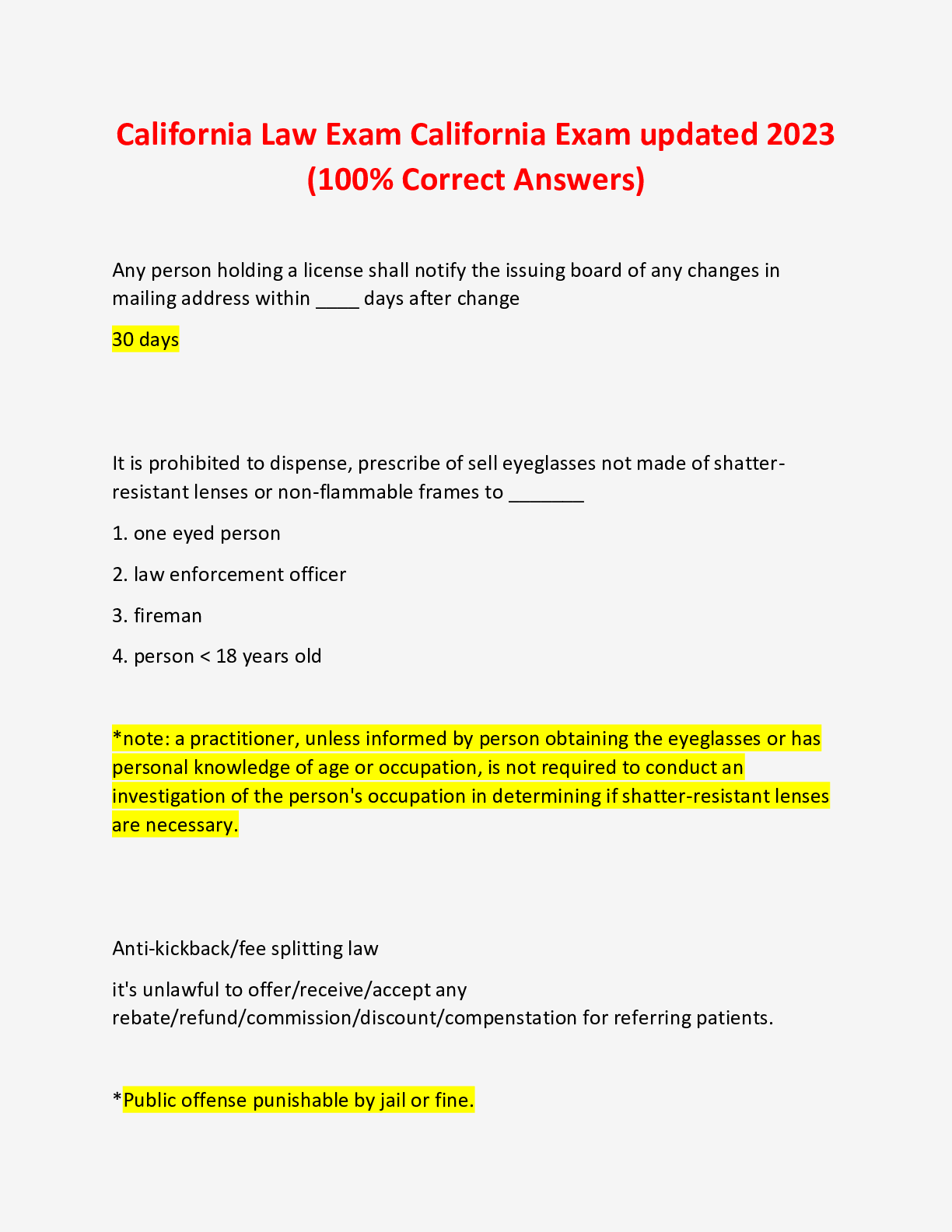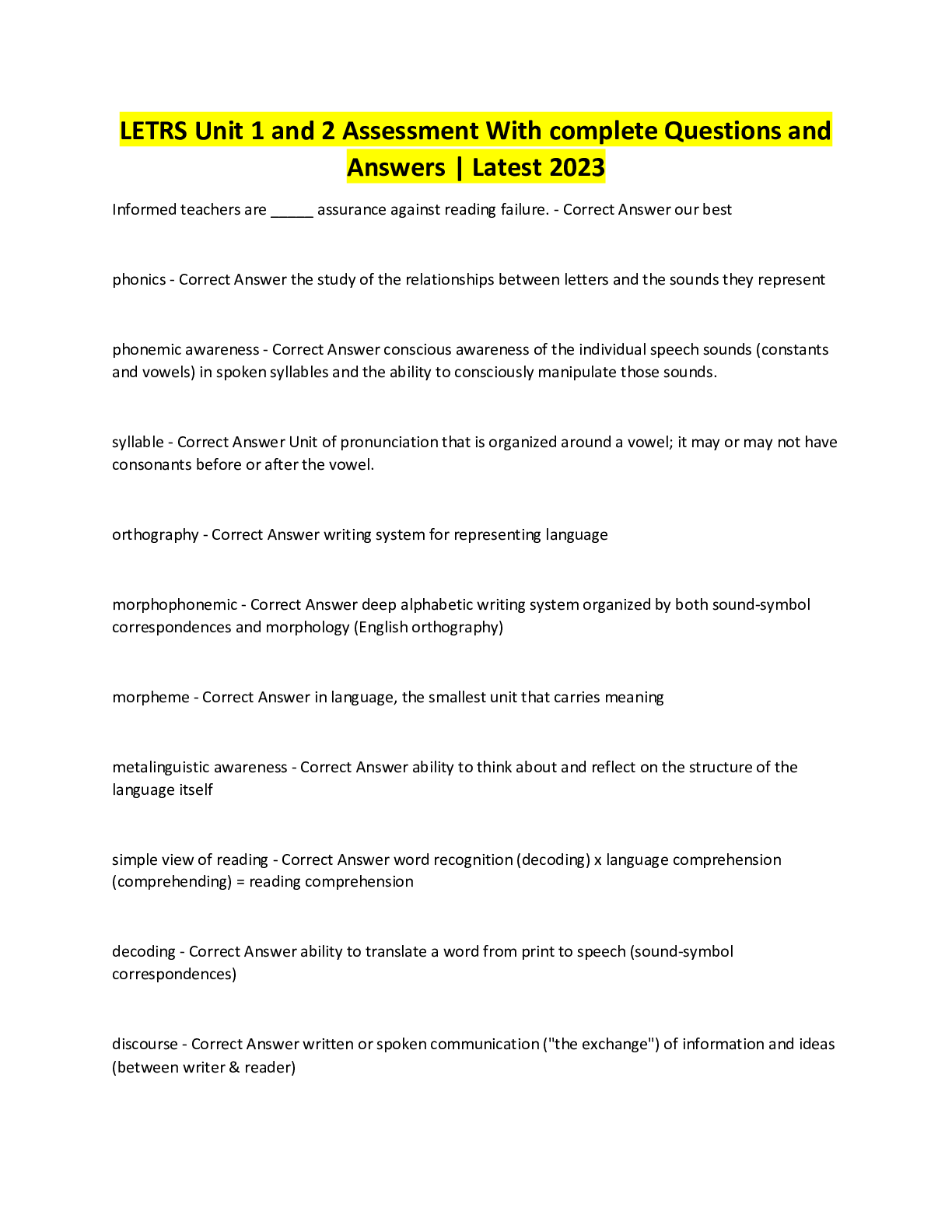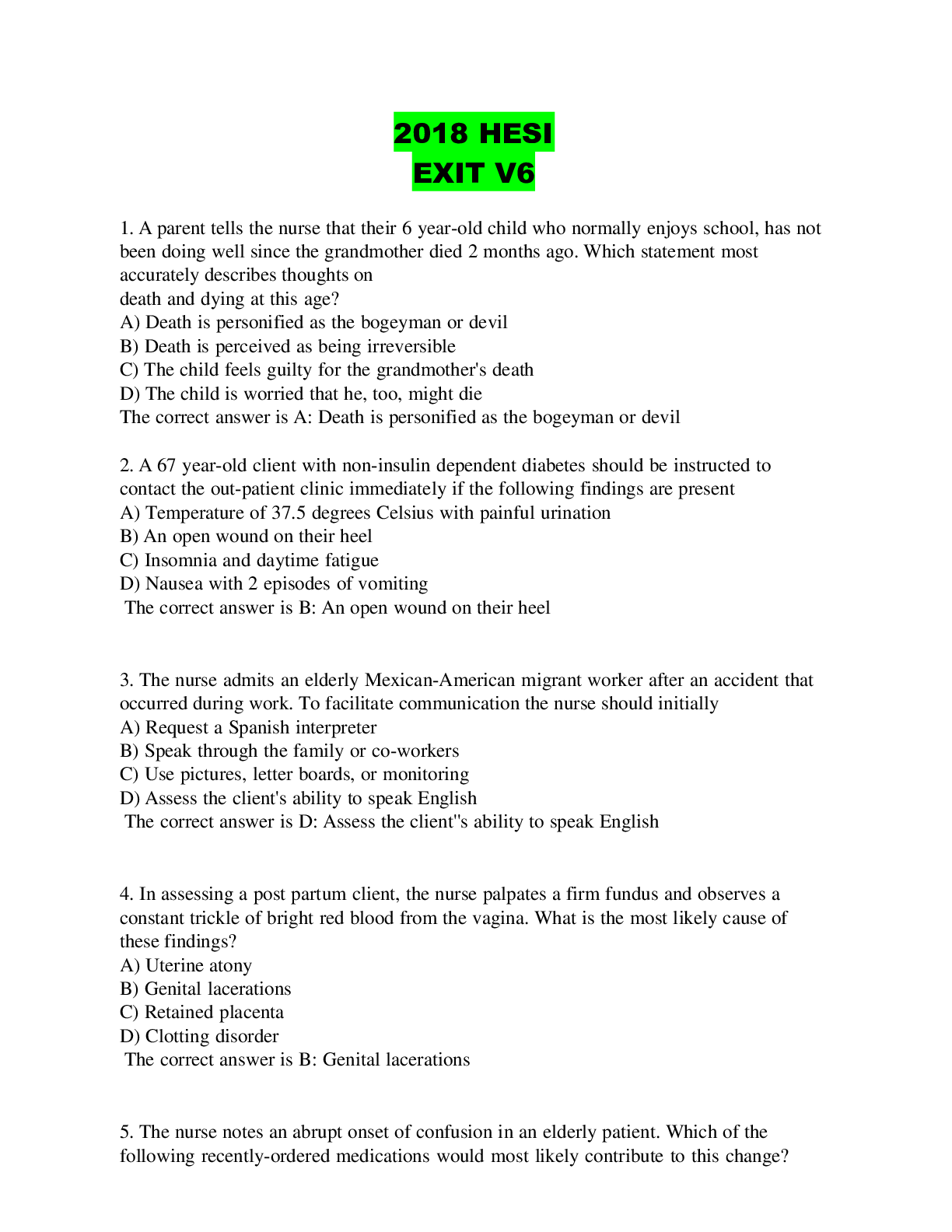*NURSING > EXAM > , Chapter 10: Antiviral Agents prepU (GRADED A) Questions and Answers REF, Karch, A. M., Focus on Nu (All)
, Chapter 10: Antiviral Agents prepU (GRADED A) Questions and Answers REF, Karch, A. M., Focus on Nursing Pharmacology, 8th ed | Download To Score An A
Document Content and Description Below
Chapter 10: Antiviral Agents Question 1 See full question3m 47s Report this Question A client believed he had “pinkeye” and waited several days before seeking care. The health care provider�... �s assessment reveals that the client has a herpes simplex infection in the eye. The nurse should teach the client about what medication? You Selected: Trifluridine Correct response: Trifluridine Explanation: Trifluridine is an ophthalmic ointment used to treat herpes simplex eye infections. Docosanol is used to treat oral and facial herpes simplex cold sores and fever blisters. Imiquimod is used to treat genital warts and perianal warts. Penciclovir is used to treat cold sores (herpes labialis) on the face and lips. Reference: Karch, A. M., Focus on Nursing Pharmacology, 8th ed., Philadelphia, Wolters Kluwer, 2020, Chapter 10: Antiviral Agents, Locally Active Antiviral Agents, p. 166. Chapter 10: Antiviral Agents - Page 166 Add a Note Question 2 See full question1m Report this Question A client's health care provider is considering the addition of efavirenz to the client's drug regimen for the treatment of recently diagnosed HIV. Which aspects of the client's medical history should prompt the nurse to question the use of this drug? You Selected: The client has hepatitis C and a history of heavy alcohol use. Correct response: The client has hepatitis C and a history of heavy alcohol use. Explanation: Efavirenz is used cautiously in clients with concomitant use of alcohol or psychoactive drugs because they increase the risk of CNS adverse effects. The drug should be used with caution in clients with a history of hepatitis B or C; they have an increased risk of hepatotoxicity. Obesity, diabetes, and adverse reactions to vaccination do not contraindicate the use of efavirenz. Reference: Karch, A. M., Focus on Nursing Pharmacology, 8th ed., Philadelphia, Wolters Kluwer, 2020, Chapter 10: Antiviral Agents, Pharmacokinetics, p. 153. Chapter 10: Antiviral Agents - Page 153 Add a Note Question 3 See full question1m 30s Report this Question When focusing on the lifestyle of the patient with HIV, what are important teaching considerations? (Select all that apply.) You Selected: Transmission can occur while on medication. Advise the patient about the adverse effect of granulocytopenia. Take drug therapy as prescribed. Correct response: Take drug therapy as prescribed. Transmission can occur while on medication. Advise the patient about the adverse effect of granulocytopenia. Explanation: It is important to assess the patient's understanding of HIV transmission and to explain that despite drug therapy, the patient can still transmit HIV to others. In addition, assess the adherence issue. Explain the importance of periodic blood monitoring to ensure the efficacy of therapy. Hematologic toxicities, including granulocytopenia and severe anemia, can occur. Signs of granulocytopenia can develop in 6 to 8 weeks, and signs of anemia can develop in 2 to 4 weeks. Reference: Karch, A. M., Focus on Nursing Pharmacology, 8th ed., Philadelphia, Wolters Kluwer, 2020, Chapter 10: Antiviral Agents, Box 10.2 Focus on Drug Therapy across the Lifespan, p. 143. Chapter 10: Antiviral Agents - Page 143 Add a Note Question 4 See full question1m Report this Question A patient with AIDS is being prepared for discharge. The nurse caring for the patient with AIDS knows the patient receives Agenerase. What dietary counseling will the nurse provide based upon the patient’s medication regimen? You Selected: Avoid high-fat meals while taking this medication Correct response: Avoid high-fat meals while taking this medication Explanation: Patients taking the protease inhibitor Amprenavir (APV) or Agenerase should be advised to avoid high-fat meals. High-fat meals decrease the blood concentration of this drug by 21%. Patients taking either of these drugs can take the drug with or without regard to meals, but the meals should not be high in fat. Fluid, sodium, and protein restrictions play no role in relation to either of these drugs. Reference: Karch, A. M., Focus on Nursing Pharmacology, 8th ed., Philadelphia, Wolters Kluwer, 2020, Chapter 10: Antiviral Agents, Table 10.2 Drugs in Focus: Agents for Herpes Virus and Cytomegalovirus, p. 148. Chapter 10: Antiviral Agents - Page 148 Add a Note Question 5 See full question58s Report this Question An immigrant and his wife are both HIV positive. The physician prescribes antiretroviral medications. However, the client, tell the nurse he is concerned about his ability to afford the treatment. What advice can the nurse provide to the client to help begin the treatment? You Selected: The client can approach social agencies and pharmaceutical companies that provide antiretroviral drugs on compassionate grounds Correct response: The client can approach social agencies and pharmaceutical companies that provide antiretroviral drugs on compassionate grounds Explanation: Antiretroviral medications are very expensive, costing as much as $10,000 to $30,000 per year in the United States. Some social agencies and pharmaceutical companies have compassionate-need programs through which the antiretroviral drugs are supplied to individuals who cannot afford them. Also, Medicaid pays about half of the cost of an antiretroviral drug therapy. The government-funded AIDS Drug Assistance Program (ADAP) covers about 30% of the cost. It is not the nurse’s responsibility to suggest that the client get a second opinion from another medical expert or select an alternative medication, different from what was already suggested. Reference: Karch, A. M., Focus on Nursing Pharmacology, 8th ed., Philadelphia, Wolters Kluwer, 2020, Chapter 10: Antiviral Agents, Clinically Important Drug–Drug Interactions, p. 149. Chapter 10: Antiviral Agents - Page 149 Add a Note Question 6 See full question50s Report this Question Nursing students are studying antiviral drug therapy in a pharmacology class. A student asks the instructor to explain why multi-drug regimens are used to treat HIV infections. The instructor responds that drug combinations are often prescribed because they You Selected: are more effective than single-drug therapy. Correct response: are more effective than single-drug therapy. Explanation: Combinations of antiviral drugs are given because, by impacting multiple portions of the life cycle of the virus, they provide more effective treatment than single-drug regimens. Multi-drug therapy also decreases viral mutations and the emergence of drug-resistant strains. Reference: Karch, A. M., Focus on Nursing Pharmacology, 8th ed., Philadelphia, Wolters Kluwer, 2020, Chapter 10: Antiviral Agents, Box 10.1 Focus on Herbal and Alternative Therapies, p. 143. Chapter 10: Antiviral Agents - Page 143 Add a Note Question 7 See full question26s Report this Question A nurse is teaching a client with herpes zoster to apply acyclovir ointment. What guidance should the nurse include in the instructions? You Selected: "Wear gloves when applying the ointment." Correct response: "Wear gloves when applying the ointment." Explanation: Clients should be taught to wear gloves when applying acyclovir ointment to lesions. Reference: Karch, A. M., Focus on Nursing Pharmacology, 8th ed., Philadelphia, Wolters Kluwer, 2020, Chapter 10: Antiviral Agents, Clinically Important Drug–Drug Interactions, p. 149. Chapter 10: Antiviral Agents - Page 149 Add a Note Question 8 See full question51s Report this Question The nurse is caring for a client with AIDS who has developed cytomegalovirus (CMV). The nurse anticipates the health care provider will order which drug to treat this client? You Selected: Ganciclovir Correct response: Ganciclovir Explanation: Ganciclovir is the antiviral drug that is prescribed for cytomegalovirus. Ribavirin is prescribed for RSV, and amantadine and oseltamivir are prescribed for influenza. Reference: Karch, A. M., Focus on Nursing Pharmacology, 8th ed., Philadelphia, Wolters Kluwer, 2020, Chapter 10: Antiviral Agents, Pharmacokinetics, p. 148. Chapter 10: Antiviral Agents - Page 148 Add a Note Question 9 See full question1m 2s Report this Question A client comes to the health care facility reporting flulike symptoms. After a thorough assessment, the client is diagnosed with influenza and is to receive oseltamivir. The nurse understands that this drug has been prescribed because the client been symptomatic for less than: You Selected: 2 days. Correct response: 2 days. Explanation: Oseltamivir is used as treatment for influenza if the client has been symptomatic for fewer than 2 days. Reference: Karch, A. M., Focus on Nursing Pharmacology, 8th ed., Philadelphia, Wolters Kluwer, 2020, Chapter 10: Antiviral Agents, Contraindications and Cautions, p. 145. Chapter 10: Antiviral Agents - Page 145 Add a Note Question 10 See full question1m 18s Report this Question A high school student, who has experienced repeated outbreaks of cold sores, reports no success with an over-the-counter (OTC) topical cream. The nurse should recognize that this student used what OTC drug? You Selected: docosanol Correct response: docosanol Explanation: Docosanol is an over-the-counter topical antiviral agent that works in the early stages of intracellular events of viral entry into the target cells. Famciclovir is an oral antiviral agent administered for herpes zoster and recurrent genital herpes. Valacyclovir is not an over-the-counter medication. Cold sores are not treated with ganciclovir. Question 1 See full question27s Report this Question A nurse is preparing to administer famciclovir to a client with a herpes virus infection. The nurse should expect to administer this drug by which route? You Selected: Oral Correct response: Oral Explanation: Famiciclovir is administered orally. Reference: Karch, A. M., Focus on Nursing Pharmacology, 8th ed., Philadelphia, Wolters Kluwer, 2020, Chapter 10: Antiviral Agents, Table 10.2 Drugs in Focus: Agents for Herpes Virus and Cytomegalovirus, p. 148. Chapter 10: Antiviral Agents - Page 148 Add a Note Question 2 See full question19s Report this Question In which of the following patients is the use of cidofovir contraindicated? You Selected: Patients with renal impairment Correct response: Patients with renal impairment Explanation: Patients with renal impairment should not be given cidofovir. Ribavirin is contraindicated in patients with cardiac disease. Antivirals should be used cautiously in patients with low blood cell counts. The nurse should also be very careful while administering rimantadine to patients who have a history of epilepsy. Reference: Karch, A. M., Focus on Nursing Pharmacology, 8th ed., Philadelphia, Wolters Kluwer, 2020, Chapter 10: Antiviral Agents, Agents for Herpes and Cytomegalovirus, p. 147. Chapter 10: Antiviral Agents - Page 147 Add a Note Question 3 See full question2m 2s Report this Question A 38-year-old man is being treated for HIV-1 with nevirapine (Viramune). Signs of severe liver dysfunction have been noted by the health care provider and a change in the drug therapy is necessary. The nurse explains to the client that: You Selected: the therapy will be discontinued. Correct response: the therapy will be discontinued. Explanation: Nevirapine drug treatment may precipitate severe hepatic reactions, a development that would necessitate discontinuing the use of the drug. Reference: Karch, A. M., Focus on Nursing Pharmacology, 8th ed., Philadelphia, Wolters Kluwer, 2020, Chapter 10: Antiviral Agents, Table 10.3 Drugs in Focus: Agents for HIV and AIDS (continued), p. 152. Chapter 10: Antiviral Agents - Page 152 Add a Note Question 4 See full question35s Report this Question When providing care to a client with a viral infection, the nurse knows that ribavirin (Virazole) for inhalation is used to treat which virus? You Selected: RSV Correct response: RSV Explanation: Ribavirin is an antiviral used to treat RSV. AIDS is not a virus; it is the condition caused by HIV. Reference: Karch, A. M., Focus on Nursing Pharmacology, 8th ed., Philadelphia, Wolters Kluwer, 2020, Chapter 10: Antiviral Agents, Agents for Influenza A and Respiratory Viruses, p. 144. Chapter 10: Antiviral Agents - Page 144 Add a Note Question 5 See full question36s Report this Question Antiretroviral drugs have different mechanisms of action. Which action below is NOT a common antiretrovirial mechanism? You Selected: Exit facilitators which remove the HIV from the cell Correct response: Exit facilitators which remove the HIV from the cell Explanation: Exit facilitators do not exist. The other 3 mechanism of action are true. Question 1 See full question1m 9s Report this Question A client is being treated with saquinavir for AIDS. The client history includes a BMI of 37.98%, hyperlipidemia, and sleep apnea. Based on the client history, why would caution be used when the client is started on saquinavir? You Selected: There are potential adverse effects associated with hyperlipidemia. Correct response: There are potential adverse effects associated with hyperlipidemia. Explanation: Saquinavir drug therapy should be used cautiously in clients with elevated triglyceride or cholesterol levels because fat redistribution and hyperlipidemia are among the adverse effects associated with the use of PIs. Because the drug is largely metabolized by the liver, saquinavir should be used with caution in clients with preexisting hepatic dysfunction, not with elevated cholesterol levels. Dosage change may be required in patients with diabetes. Association with cardiovascular events is not the reason for the caution. Reference: Karch, A. M., Focus on Nursing Pharmacology, 8th ed., Philadelphia, Wolters Kluwer, 2020, Chapter 10: Antiviral Agents, Protease Inhibitors, p. 155. Chapter 10: Antiviral Agents - Page 155 Add a Note Question 2 See full question1m 10s Report this Question The student nurse has learned that HIV is a retrovirus. Reverse transcriptase is the enzyme it contains. The student understands this enzyme when making which statement? You Selected: Reverse transcriptase is used to turn the RNA of the virus into DNA. Correct response: Reverse transcriptase is used to turn the RNA of the virus into DNA. Explanation: Retroviruses attack the host just like a virus; the difference is that RNA is the primary component of the virus instead of DNA. Retroviruses also contain an enzyme called reverse transcriptase that is used to turn the RNA of the virus into DNA, helping to reproduce more of the virus. Reference: Karch, A. M., Focus on Nursing Pharmacology, 8th ed., Philadelphia, Wolters Kluwer, 2020, Chapter 10: Antiviral Agents, Integrase Inhibitors, p. 159. Chapter 10: Antiviral Agents - Page 159 Add a Note Question 3 See full question25s Report this Question A patient diagnosed with acute primary HIV infection is in the clinic. What treatment should be initiated for this patient? You Selected: Combination antiretroviral therapy Correct response: Combination antiretroviral therapy Explanation: People with acute primary HIV infection should be treated with combination antiretroviral therapy to suppress virus replication to levels below the limit of detection of sensitive plasma HIV RNA assays. Reference: Karch, A. M., Focus on Nursing Pharmacology, 8th ed., Philadelphia, Wolters Kluwer, 2020, Chapter 10: Antiviral Agents, Box 10.1 Focus on Herbal and Alternative Therapies, p. 143. Chapter 10: Antiviral Agents - Page 143 Add a Note Question 4 See full question1m 13s Report this Question The nursing instructor is discussing HIV/AIDS with the junior nursing class. The instructor tells the students that it is important to understand how HIV-1 integrates itself into a person’s immune system and how immunity plays a role in the course of HIV disease. What else is this knowledge essential for? You Selected: Understanding medication therapy Correct response: Understanding medication therapy Explanation: Because HIV infection is an infectious disease, it is important to understand how HIV-1 integrates itself into a person’s immune system and how immunity plays a role in the course of HIV disease. This knowledge is also essential for understanding medication therapy and vaccine development. Reference: Karch, A. M., Focus on Nursing Pharmacology, 8th ed., Philadelphia, Wolters Kluwer, 2020, Chapter 10: Antiviral Agents, Nursing Considerations for Patients Receiving Agents for Influenza A and Respiratory Viruses, p. 147. Chapter 10: Antiviral Agents - Page 147 Add a Note Question 5 See full question30s Report this Question Which microorganism is known to cause retinitis in people with HIV/AIDS? You Selected: Cytomegalovirus Correct response: Cytomegalovirus Explanation: Cytomegalovirus is a species-specific herpes virus. Cryptococcus neoformans is a fungus that causes an opportunistic infection in those with HIV/AIDS. Mycobacterium avium is an acid-fast bacillus that commonly causes a respiratory illness. Pneumocystic carinii is an organism that is thought to be protozoan but believed to be a fungus based on its structure. Reference: Karch, A. M., Focus on Nursing Pharmacology, 8th ed., Philadelphia, Wolters Kluwer, 2020, Chapter 10: Antiviral Agents, Agents for Herpes and Cytomegalovirus, p. 147. Chapter 10: Antiviral Agents - Page 147 Add a Note Question 6 See full question49s Report this Question There are many ethical issues in the care of clients with HIV or HIV/AIDS. What is an ethical issue healthcare providers deal with when caring for clients with HIV/AIDS? You Selected: Disclosure of the client’s condition Correct response: Disclosure of the client’s condition Explanation: Despite HIV-specific confidentiality laws, clients infected with AIDS fear that disclosure of their condition will affect employment, health insurance coverage, and even housing. Since healthcare providers do not share a client’s diagnosis with a support group, option A is incorrect. Caring for a client with an infectious terminal illness that can be transmitted to other people is a concern for healthcare providers but it is not an ethical issue. Reference: Karch, A. M., Focus on Nursing Pharmacology, 8th ed., Philadelphia, Wolters Kluwer, 2020, Chapter 10: Antiviral Agents, Viruses, p. 142. Chapter 10: Antiviral Agents - Page 142 Add a Note Question 7 See full question1m 23s Report this Question A nurse is caring for a client who is taking acyclovir. What is likely to be a priority nursing diagnoses for this client? You Selected: Imbalanced Nutrition: More than body requirements related to drug adverse effects Correct response: Imbalanced Nutrition: Less than body requirements related to drug adverse effects Explanation: Common adverse effects of acyclovir and other antiviral drugs include anorexia, nausea, and vomiting, all of which can interfere with the ckient's nutritional intake. Reference: Karch, A. M., Focus on Nursing Pharmacology, 8th ed., Philadelphia, Wolters Kluwer, 2020, Chapter 10: Antiviral Agents, Box 10.2 Focus on Drug Therapy across the Lifespan, p. 143. Chapter 10: Antiviral Agents - Page 143 Add a Note Question 8 See full question54s Report this Question Specific antiretrovirals work in different ways. Which describes one mechanism of action of antiretrovirals? You Selected: They are protease inhibitors, which block the protease enzyme so the new viral particles cannot mature. Correct response: They are protease inhibitors, which block the protease enzyme so the new viral particles cannot mature. Explanation: Protease inhibitors block the protease enzyme that is necessary for the new viral particles to mature. Protease inhibitors do not block viral entry into cells. Entry inhibitors prevent HIV from attaching to a host cell for initial entry. Entry inhibitors do not prevent the virus from breaking down DNA. Reference: Karch, A. M., Focus on Nursing Pharmacology, 8th ed., Philadelphia, Wolters Kluwer, 2020, Chapter 10: Antiviral Agents, Clinically Important Drug–Drug Interactions, p. 153. Chapter 10: Antiviral Agents - Page 153 Add a Note Question 9 See full question1m 6s Report this Question How is the risk of renal impairment best minimized when foscarnet is administered? You Selected: Monitoring renal function two or three times weekly during induction Correct response: Monitoring renal function two or three times weekly during induction Explanation: When foscarnet is administered, renal impairment may be minimized by monitoring renal function (e.g., at baseline; two or three times weekly during induction; at least every 1 or 2 weeks during maintenance therapy) and reducing dosage accordingly. The drug should be stopped if creatinine clearance drops to less than 0.4 mL/ min/kg. Adequate hydration should also be maintained throughout the course of drug therapy. Reference: Karch, A. M., Focus on Nursing Pharmacology, 8th ed., Philadelphia, Wolters Kluwer, 2020, Chapter 10: Antiviral Agents, Agents for Herpes and Cytomegalovirus, p. 147. Chapter 10: Antiviral Agents - Page 147 Add a Note Question 10 See full question1m 12s Report this Question A client with AIDS develops cytomegalovirus retinitis. The health care provider orders cidofovir. The nurse would prepare the client for administration of the drug by which route? You Selected: Intravenous Correct response: Intravenous Explanation: Cidofovir is given by intravenous infusion over 1 hour. It is not given orally, topically, or subcutaneously. [Show More]
Last updated: 1 year ago
Preview 1 out of 18 pages
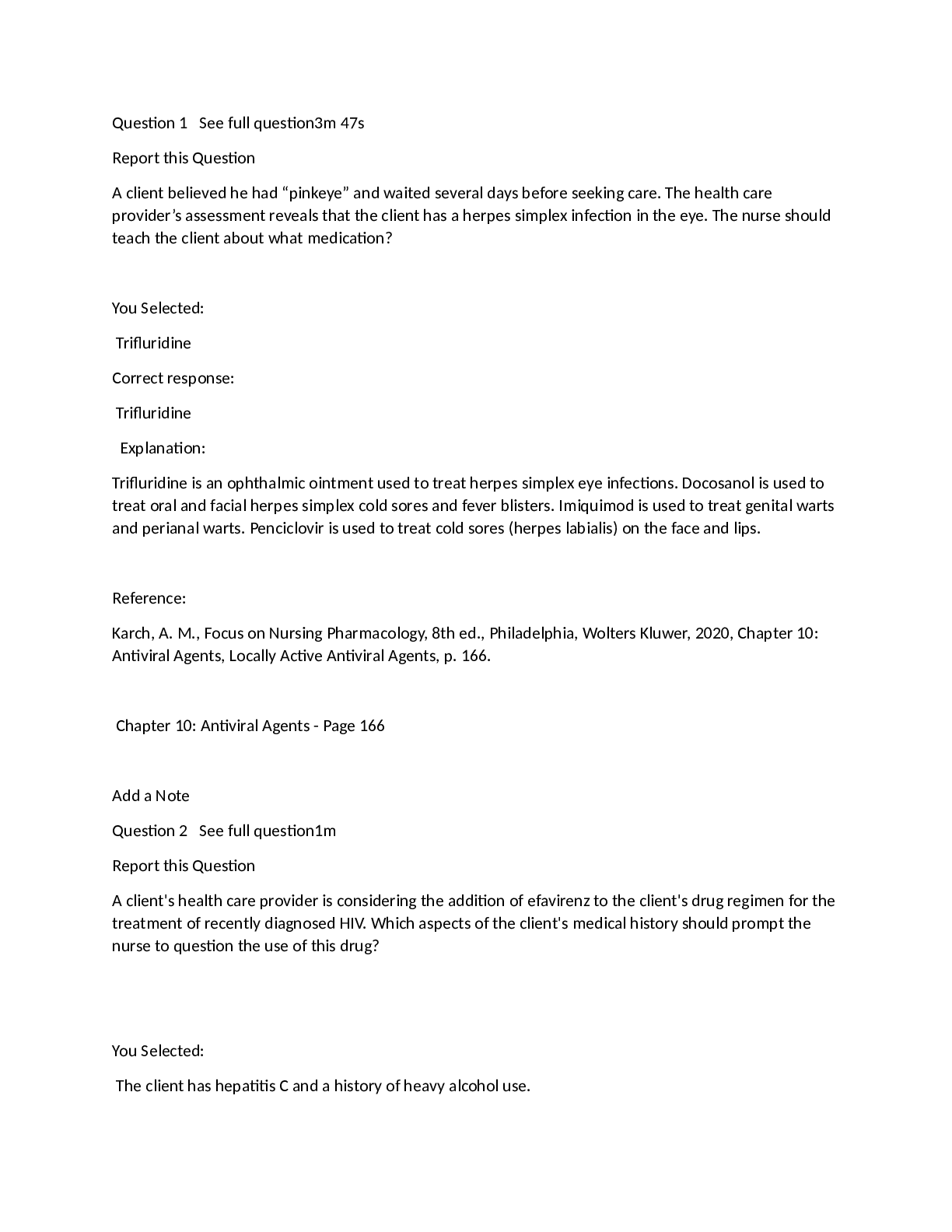
Reviews( 0 )
Document information
Connected school, study & course
About the document
Uploaded On
Oct 15, 2021
Number of pages
18
Written in
Additional information
This document has been written for:
Uploaded
Oct 15, 2021
Downloads
0
Views
48
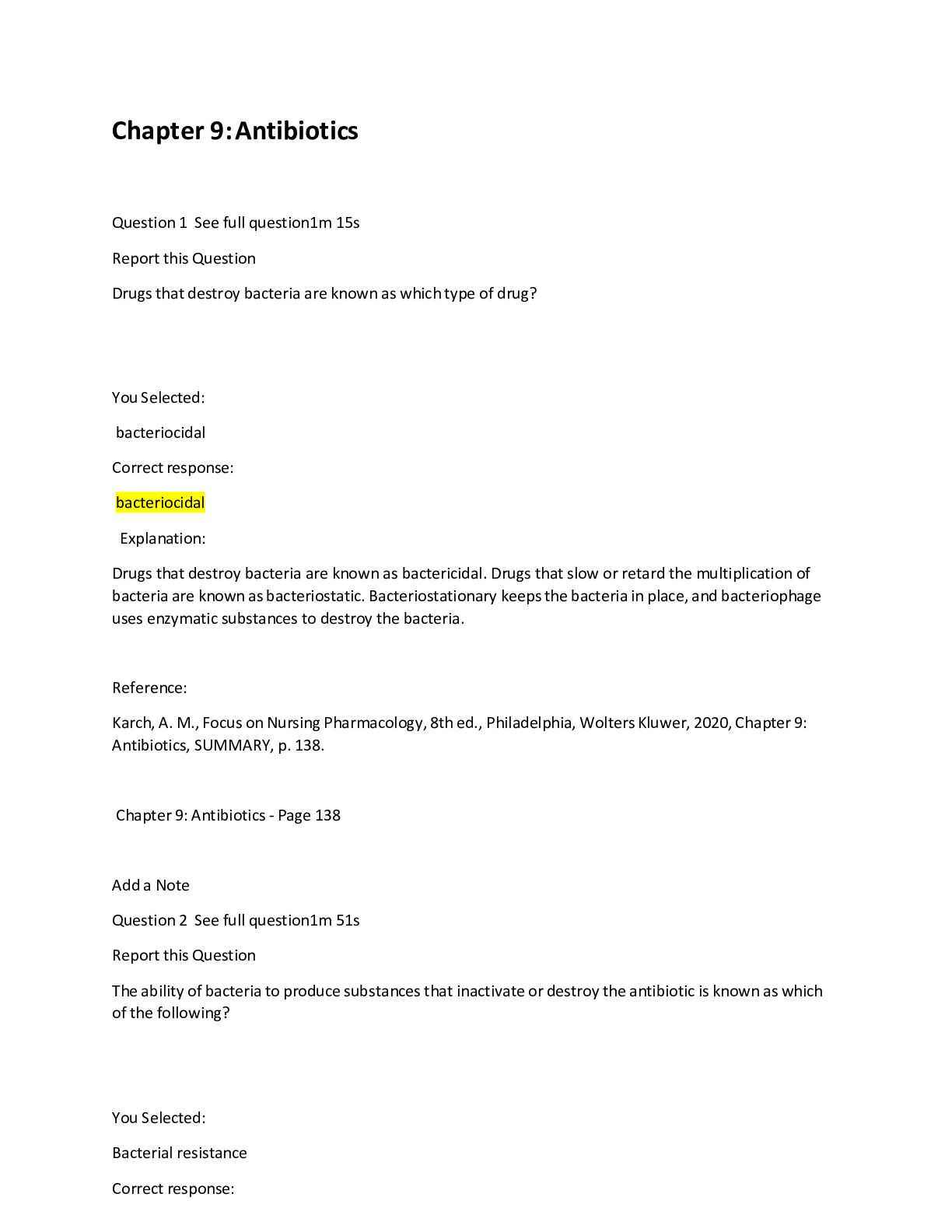



.png)










